Plants to Attract Hummingbirds: A Native Gardener’s Guide to Hummingbird Magnets


Hummingbirds are among the most beautiful and unique birds to visit a backyard garden — dazzling, fast-moving flashes of iridescent color. These tiny, energetic creatures need a constant source of high-energy nectar to survive, which is why planting a hummingbird garden is one of the best ways to support them.
While hummingbird feeders can provide a temporary boost, the most sustainable way to draw in more hummingbirds is by growing the right hummingbird plants — full of nectar rich flowers, vivid blooms, and naturally evolved relationships with the birds themselves.
In this guide, we’ll walk through the plants to attract hummingbirds, garden design tips, and regionally adapted native plants that help hummingbirds thrive while also benefiting other pollinators.
Why Plant for Hummingbirds?

Hummingbirds tend to return to the same spots year after year — and when your yard offers a reliable source of sweet nectar, they'll keep coming back. By growing native flowers that attract hummingbirds, you're not only bringing life and color to your garden — you're building a critical piece of hummingbird habitat.
Plus, these native plants are often deer resistant, beautiful to look at, and low-maintenance once established.

What Makes a Plant Hummingbird-Friendly?

To attract hummingbirds, flowers should offer:
- Tubular flowers that match their long beaks
- Bright reds, oranges, pinks, and purples
- Nectar rich blooms throughout the growing season
- A preference for full sun or partial shade
- Resistance to drying out (or at least tolerance for moist well-drained soil)
- Ideally, support for other organisms in the shared ecosystem
Hummingbirds love bright blooms, especially trumpet shaped flowers they can hover near while feeding.
How to Design a Hummingbird Garden

Creating a hummingbird garden is all about layering for color, bloom time, and vertical diversity.
Key design tips:
- Group plants in elongated clusters to make flowers easier to find
- Include early, mid, and late summer bloomers
- Ensure at least six hours of full sun for most plantings
- Use well drained soil amended with compost
- Incorporate hanging baskets for vertical interest
Want hummingbirds zipping around all season long? Choose native plants that bloom from mid summer through fall.

10 Plants to Attract Hummingbirds (Including Native Favorites)
Let’s explore the top plants that attract hummingbirds — with a special emphasis on native species and pollinator-friendly options.
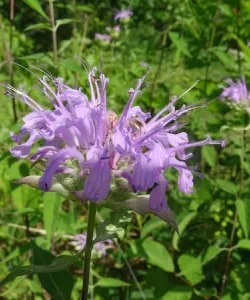
Wild Bergamot thrills with its unusual purple-pink flowers that attract all manner of bees and butterflies. Grows best when cut in half in early summer, which reduces the final height. Wild Bergamot is prone to powdery mildew that turns the foliage whitish, especially on the lower portion of the plant, and causes lower leaves to drop off. It will not harm the plant but may be unsightly. Hide the tired foliage by tucking Wild Bergamot behind other tall plants. Wild Bergamot spreads by rhizomes (underground stems). To keep it in one place, use a shovel to slice around the plant and sever rhizomes in spring.
- Color: Pink, red, or purple
- Bloom Time: Mid to late summer
- Soil: Well drained
- Loved by: Hummingbirds, butterflies, and other pollinators
This fragrant, nectar rich flower is a true hummingbird magnet and a favorite of many other benefical organism.
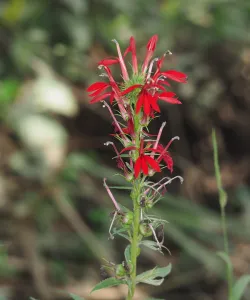
Cardinal Flower's wands of crimson flowers are brilliant in the late summer garden. Its long, tubular flowers have evolved to be pollinated by hummingbirds, whose beaks reach deep for nectar while their foreheads get brushed with pollen. Butterflies are another frequent visitor to this flower. Cardinal Flower naturally occurs in wetlands and floodplains, so it can handle your yard's wet areas in addition to average garden soils. To prolong this plant's life, brush aside any leaves or debris that lay on its low-growing rosette of winter leaves as these are very sensitive to being covered.
- Color: Bright red
- Light: Partial sun to full sun
- Moisture: Evenly moist, loamy soil preferred
Flowers attract hummingbirds like magnets, especially ruby throated hummingbirds.

The bright red pop-pom flowers of Scarlet Beebalm attract both hummingbirds and butterflies. This plant smells nice, too! A deer-resistant plant is in the mint family, Scarlet Beebalm's fragrant leaves are traditionally used in medicinal tea (hence its alternative common name, Oswego Tea). After blooming, Scarlet Beebalm can develop white spots on its leaves, but these are not a threat to the plant. Thinning the plant's stems can improve airflow and reduce the visual impact.
- A close cousin to Wild Bergamot, offers eye-catching red flowers
- Drought tolerant and supports other pollinators too
- Great for patial sun borders
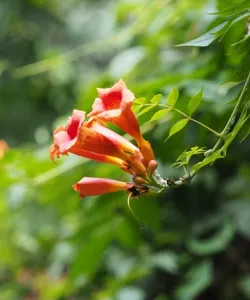
American Trumpet Vine, also called Trumpet Creeper Vine, is a robust and fast-growing climber that can reach lengths of up to 40 feet, making it perfect for covering trellises, fences, and other structures. Its large, showy, trumpet-shaped flowers, which appear in clusters from mid-summer to early fall, are a vibrant orange-red and highly attractive to hummingbirds and other pollinators, providing a vital nectar source. The vine's lush, green foliage can grow quite densely, which can help cool buildings, shade patios, and provide privacy. While it thrives in full sun and well-drained soils, it is adaptable and can tolerate a range of conditions, including poor soils and urban pollution. Flowers mature into large and attractive seed pods towards the end of the season.
- Large vine with red-orange trumpet shaped flowers
- Needs space — can grow 20+ feet tall
- Great for trellises or back fences
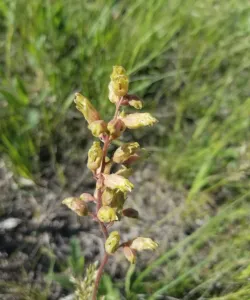
Prairie Alumroot, distinguished by heart-shaped leaves with ruffled edges, forms a small mound of green foliage. Unlike its purple and orange cultivated counterparts, its green leaves better support wildlife. Delicate flower spikes, speckled with small green blooms, attract bees and butterflies. Prairie alum root gets a bit taller each year, but division every few years will help keep its mounding shape.
- Small, delicate blooms held above textured foliage
- Works in partial shade or full shade
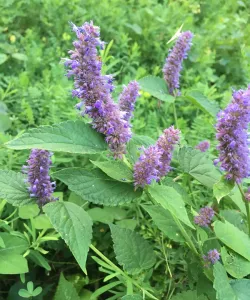
Lavender hyssop has many standout traits that make it a great addition to any native garden. Incredibly long-blooming, its purple flowers bloom from mid-summer through fall. It's a top pollinator plant that attracts droves of native bees. The licorice-scented foliage is edible and deters deer. Lavender hyssop can handle drought once established and is well-behaved in the garden.
- Tall spikes with nectar rich flowers
- Grows best in dry, well drained soil
- Excellent for hummingbird gardens in hot, sunny areas
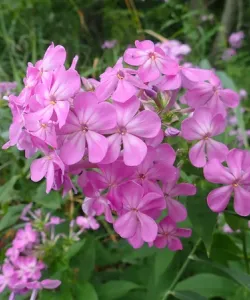
Garden Phlox is a native plant naturally found in woodland clearings and edges, but it's so commonly cultivated that it's earned the name garden phlox. In late summer and early fall, it erupts into airy round clusters of strongly fragrant pink flowers. Garden Phlox attracts hummingbirds and clearwing moths, which are hummingbird mimics (they're also called hummingbird moths for this reason)! These fascinating moths have feathery bodies and fly and hover just like hummingbirds. Garden Phlox can suffer from powdery mildew, which causes white spots on the foliage that do not harm the plant. Phlox can aggressively self-seed and is best paired with other vigorous plants.
- Tall and colorful with fragrant flowers
- Great for partial sun or full sun
- Attracts butterflies and hummingbirds
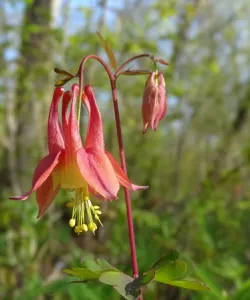
Planting columbine helps feed pollinators in the early spring, as it's one of the first flowers to bloom. Bell-shaped flowers hang airily over delicate foliage, and their red color attracts hummingbirds. Columbine is a very adaptable plant that thrives in shade or sun and does well in most sites as long as it's not too wet. Its shiny black seeds bounce over the ground, slowly spreading new populations throughout the garden. Foliage can look tired in summer some years and can be cut back for a tidier look.
- Spring bloomer with nodding tubular flowers
- Thrives in part shade
- Perfect for hummingbird habitat in woodlands

Big Blue Sage, is renowned for its vivid, azure blue flowers that bloom from late summer into fall. This hardy perennial features elongated, lance-shaped leaves and a loose, branching form that reaches up to 3 to 5 feet in height. Big Blue Sage's long blooming period and striking color make it a favorite among gardeners looking to attract pollinators such as bees and butterflies. It thrives in full sun and well-drained soil, making it an excellent choice for borders, native plant gardens, and rockeries.
- Bright blue blooms from mid summer through fall
- Tolerates drought and thrives in full sun
- Mix with hummingbird vine for layered color
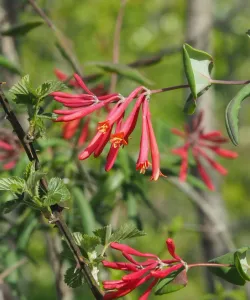
Don't be misled by the name, Coral Honeysuckle (also called Trumpet Honeysuckle) is a non-invasive, native vine distinguished by its clusters of bright, tubular flowers that bloom from spring to summer. The flowers, ranging in color from deep red to coral orange, are a magnet for hummingbirds and butterflies, providing a reliable source of nectar for each. Unlike its invasive relatives, coral honeysuckle maintains a more controlled growth habit, making it an ideal choice for gardeners looking to cover arbors, trellises, or fences without overwhelming other plants. Coral Honeysuckle prefers full sun to partial shade and well-drained soil. In addition to its floral display, it produces red berries in the fall that support various bird species.
- A native hummingbird vine with long red tubular flowers
- Blooms in late spring and reblooms through late summer
- Gorgeous on fences or pergolas

6 Plants to Avoid Despite Their Ability to Attract Hummingbirds

Butterfly Bush
- Often sold as a hummingbird and butterfly attractant
- While it does offer nectar, it supports no native caterpillars or insect life
- Highly invasive in many regions (especially the Pacific Northwest and Northeast)
- Crowds out native species in disturbed areas
- → ✅ Use native alternatives like blue sage or blazing star (Liatris)
Common Lantana
- Popular in hot climates and container gardens
- Some cultivars offer nectar, but the species is toxic to animals and aggressively invasive in warmer zones
- Alters natural succession in disturbed habitats
- → ✅ Swap in hummingbird mint (Agastache) or coral honeysuckle
Fuchsia hybrids
- Often used in hanging baskets for hummingbirds
- Non-native and generally offer little ecological support
- Many are sterile or grown with pesticides
- → ✅ Consider using columbine (Aquilegia canadensis) or coral bells for shade-tolerant alternatives
Red Hot Poker
- Commonly recommended for its tubular flowers
- Native to Africa and offers minimal wildlife support in North America
- → ✅ Replace with cardinal flower (Lobelia cardinalis)
Petunias and Impatiens
- Ubiquitous in bedding and container arrangements
- Offer little to no real nectar
- Typically grown with heavy pesticide use and are often sterile
- → ✅ Use bee balm, hummingbird mint, or native annuals instead
Bonus: Companion Plants That Attract Butterflies and Other Pollinators

Many hummingbird plants also attract butterflies and beneficial insects, making them powerful additions to a biodiverse garden.
Great choices include:
- Golden Alexanders
- Coneflowers
- Yarrow
- Liatris
Mixing in plants that attract a range of pollinators helps build a more resilient hummingbird habitat.
Water, Shelter, and Other Habitat Tips

While plants are the foundation, great hummingbird gardens also include:
- Fresh water (a shallow fountain or mister)
- Even a well-maintained birdbath is often enough
- Small trees or shrubs for shelter
- Nesting materials like soft moss or spider webs
- Protection from strong winds
Avoid pesticides and keep regular watering in mind during dry spells, especially for new plantings.
Where to Get the Best Hummingbird Plants
The best place to get plants to attract hummingbirds is from native plant nurseries or eco-conscious local nurseries that focus on non-invasive species.
Pressed for time or don't have something closer? Shop from My Home Park's curated online collections designed for your zip code and light conditions. Our kits, single species trays, and seed mixes make starting your own native hummingbird garden simple, effective, and budget-friendly.

Final Thoughts: Let Your Garden Take Flight

Planting for hummingbirds is more than a hobby — it’s a celebration of life, motion, and color. These beautiful birds bring energy to every space they visit, and by planting nectar rich flowers, you’re giving them what they need to survive and thrive.
Ready to start?
🛒 Browse Hummingbird Garden Kits
🌸 Explore Native Plants for Your Region
📬 Try Our Custom Design Service Today
With the right hummingbird plants, a little planning, and a sunny space, you can turn your garden into a humming, fluttering oasis.
Share this article


